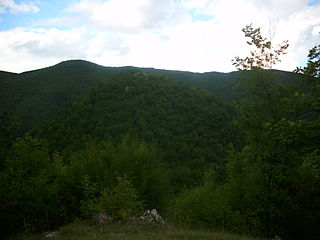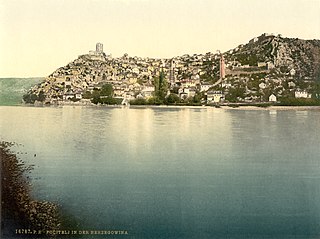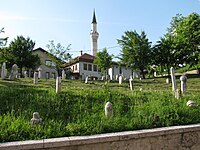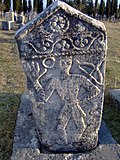
Alija Izetbegović was a Bosnian politician, Islamic philosopher and author, who in 1992 became the first president of the Presidency of the newly independent Republic of Bosnia and Herzegovina. He later served as the first chairman of the Presidency of Bosnia and Herzegovina.

Jajce is a town and municipality in the Central Bosnia Canton of the Federation of Bosnia and Herzegovina, an entity of Bosnia and Herzegovina. According to the 2013 census, the town has a population of 7,172 inhabitants, with 27,258 inhabitants in the municipality, It is situated in the region of Bosanska Krajina, on the crossroads between Banja Luka, Mrkonjić Grad and Donji Vakuf, on the confluence of the rivers Pliva and Vrbas.

Tourism in Bosnia and Herzegovina is a fast-growing sector making up an important part in the economy of the country.

Novo Goražde is a town and municipality in Republika Srpska, Bosnia and Herzegovina. Its center is the village of Kopači. As of 2013, it has a population of 3,117 inhabitants.

Doboj Fortress or Gradina (Градина) is located in the city of Doboj, Bosnia and Herzegovina. Throughout its turbulent history, the fortress has been burned and ransacked at least 18 times as per official records. Of note is that Doboj fortress was considered to be a royal Kotromanić property, unlike Great Bosnian Duke Hrvoje's Zvečaj fortress or Sandalj Hranić's Blagaj fortress, which were centers of their respective duchies.

The Walled City of Jajce is a medieval fortified nucleus of Jajce in Bosnia and Herzegovina, with Jajce Citadel high above town on top of pyramidal-shaped steep hill, enclosed with approximately 1,300 metres (4,300 ft) long defensive walls,. It is one of the best preserved fortified capitals of the Bosnian Kingdom, the last stronghold before the kingdom dissolved under the pressure of military advancement at the onset of Ottoman Empire takeover.

The White Fortress is an old fort overlooking the historic core of Sarajevo. It is a national monument of Bosnia and Herzegovina. Bijela Tabija is 667 metres (2,188 ft) above sea level. Bijela Tabija is a protruding part of the wall of what was historically known as the old Vratnik City, and dominates the Eastern, the natural entrance to Sarajevo. It is built of stone and it used to house a gun-crew and an ammunition storage. Its thick walls have openings for cannons.

The Goat's Bridge is a large stone bridge that crosses the Miljacka river to the east of Sarajevo, Bosnia and Herzegovina.
Kotor or Kotorgrad, was a medieval fortress above the present settlement of Kotor in Kotor Varoš, Bosnia and Herzegovina, Republic of Srpska entity, municipality of Kotor Varoš. During the medieval Kingdom of Bosnia, the fortress is developed to be a first and favorite seat of Hrvoje Vukčić, lord of Donji Kraji, parish Vrbanja, along of other two, Ključ and Jajce.

Vratnik, also known as Stari grad Vratnik, is one of the oldest neighbourhoods in Sarajevo, Bosnia and Herzegovina.

The Yellow Fortress or Yellow Bastion is a cannon fortress at the entrance of the "Walled City of Vratnik". It was built between 1727 and 1739 in area called Jekovac, close to the Jajce Barracks and the Jekovac water reservoir. It served as one of the defense points against the Austro-Hungarian troops in 1878. The fortress was damaged and rebuilt several times. The most recent renovation took place in 1998.

The Battle of Jajce took place in January 1518 during a series of wars between the Ottoman forces of Husrev Beg, Beylerbey of the Bosnia Eyalet, and the Hungarian and Croatian forces led by Croatian Ban Petar Berislavić. The battle was a part of the Croatian–Ottoman wars and Ottoman–Hungarian wars.

Trg oslobođenja - Alija Izetbegović is a square in Sarajevo, Bosnia and Herzegovina. It lies between the municipalities Stari Grad and Centar. It links the main pedestrian thoroughfare of the Sarajevo old town, Ferhadija street, with Zelenih Beretki street, with the Dom Armije (1881). On its east side it hosts the Orthodox Cathedral (1874) and the University of Sarajevo School of Economics and Business. On its west is the Svjetlost building, while at its south, beyond Zelenih Beretki, stands the Dom Armije (1881)

Ključ fortrass, locally known as Stari grad Ključ, is a medieval castle complex in the village of Ključ, Gacko, Bosnia and Herzegovina. The historic area includes the Ključ fortress, the Podključ castle town as part of a wider area just beneath of the fortress, the Ključ Mosque with a harem. The site has been declared a National monument of Bosnia and Herzegovina by the Commission to preserve national monuments of Bosnia and Herzegovina.

Sokograd, also known as Pliva or Plivski grad, Pliva-Soko, Sokol-grad, Soko-grad, or simply Soko or Sokol, is a medieval fortress with a castle town in the Pliva river valley, between Gerzovo and nearby Šipovo, in Šipovo municipality, Republika Srpska entity of Bosnia and Herzegovina. It was a very important fortress for the medieval Bosnian state, and the center of the župa Pliva. It was built in a canyon on a steep slope high above the river Sokočnica, which flows into Pliva in Šipovo.

Ključ Fortress is a medieval fortress in Bosnia and Herzegovina, above the modern-day town of Ključ. It is located on an elongated slope on high rocks that dominate the valley of the river Sana. Before it was redeveloped, there was a small ancient fortress from Roman times.

Walled town of Počitelj is a medieval fortified nucleus of Počitelj historic village, in the municipality of Čapljina, Bosnia and Herzegovina. Due to its significant architectural and urbanistic historical value, it is considered an open-air museum. The Walled town is nested in a natural karst amphitheater along the left bank of the Neretva river, on the main road Mostar-Metković. The walled nucleus is protected as a National Monument of Bosnia and Herzegovina. The architectural ensemble of Počitelj is also proposed as such for inscription into the UNESCO's list of World Heritage Sites. The bid for inscription is currently placed on the UNESCO Tentative list.

Ljubuški Fortress, also known as Herceg Stjepan's Fortress, or the Old town of Ljubuški, is a medieval fortress in the municipality of Ljubuški, Bosnia and Herzegovina.
Kušlat, also Kučlat, is medieval fortress in Bosnia and Herzegovina. The fortress is located south of Zvornik, not far from Paljević, above the confluence of the Jadar and Drinjača, in Zvornik municipality. The fortress had its own podgrađe, with a trg or trgovište, and was called Podkučlat. Podkučlat also had a medieval custom for collecting taxes from merchants who traded goods in the region.



































